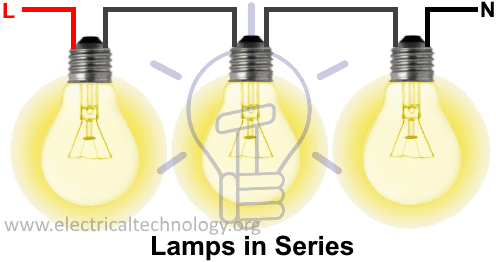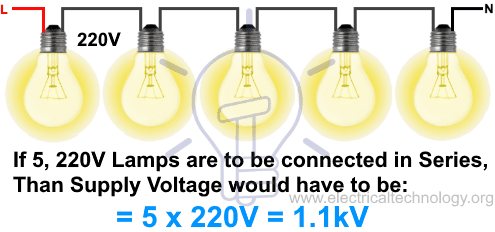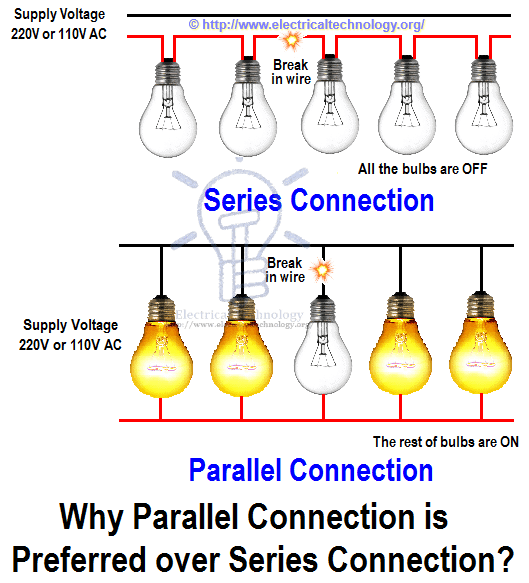How To Wire Lights in Series?
How to Connect Lights Points in Series?
In today’s basic electrical wiring installation tutorial, we will show how to wire lighting points in sires. Although, we know that series connection for household wiring like fans, switches, light bulbs etc is not a preferred way instead of parallel or series-parallel wiring. But in some cases, we need to wire and connect electrical appliances in series as well based on the system requirements. One of the most common configurations of lights in series is a Christmas lights string where LEDs and small bulbs are mostly connected in series.

In above fig, all the three light points are connected in series. Each lamp is connected to the next one i.e. the L (Line also known as live or phase) is connected to the first lamp and other lamps are connected through middle wire and the last one wire as N (Neutral) connected to the supply voltage then.
according to the series circuit analogy, the flowing current is same in all these incandescent bulbs / lamps but the voltage are different as opposed to the parallel circuit where voltage are same at each point where current are different.
One of the major disadvantage of series lighting circuit, adding or removing one lamp from the circuit will affect the over all circuit i.e. others lamps will dim in light and other connected devices and appliances will not get the sufficient or required operated voltage because the voltage in series circuit is different at each point but the flowing current is same.
Any number of lighting points or load can be added (according to the circuit or sub-circuit load calculation) in this kind of circuit by simply extending the L and N conductors to other lamps but they will not glowing according to the rated output efficiency. in short, adding more light bulbs in series circuit will dim the rest of the light points.
another major defect of series lighting circuit is that as all lamps or bulbs are connected between Line L and Neutral N accordingly, if one of the light bulb gets faulty, the rest of the circuit will not work as the circuit will be open as shown in fig below. Here, you can see there is a cut in the line wire connected to lamp 3, so the bulb is switch OFF and the rest circuit is working properly i.e. bulbs are glowing.

Disadvantages of Series Lighting Circuit.
- The break in the wire, failure or removal of any single lamp will break the circuit and cause all of the others to stop working as there is only one single path of current to flow in the circuit.
- If more lamps are added in series lighting circuit, they will all be reduced in brightness. because voltage are shared in series circuit. If we add more loads in series circuit, the over voltage drop is increases which is not a good sign for electrical appliances protection.
- Series Wiring is “ALL or NONE” type wiring mean all the appliances will work at once or all of them will disconnect if fault occurs at any one of the connected device in series circuit.
- High supply voltage are needed if we need to add more load (light bulbs, electric heaters, air conditioner etc) in the series circuit. For example, If five, 220V Lamps are to be connected in Series, Than Supply Voltage would have to be: 5 x 220V = 1.1kV.
- The overall series circuit resistance increases (and current decreases) when more load added in the circuit.
- According to future need, only those electrical appliances should be added in the current series circuit if they has the same current rating as current are same at each point in series circuit. However, we know that electrical appliances and devices i.e. light bulbs, fan, heater, air conditioner etc have different current rating, therefore, they can not be connected in series circuit for smooth and efficient operation.
Advantages:
- Less size of wire cable is required in series wiring.
- We use to protect the circuit to connect fuse & circuit breakers in series with other appliances.
- Series circuit don’t get overhead easily due to high resistance when more load added in the circuit.
- The lifespan of battery in series circuit is more as compared to parallel.
- It is most simple method of electrical wiring and fault can be easily detect and repair as compared to parallel or series-parallel wiring.

Good to know:
- Switches and fuses must be connected through line (Live) wire.
- Connecting electrical devices and appliances like fan, outlet, light bulbs etc in parallel is a prefer way instead of series wiring.
- Parallel or series-parallel wiring method is more reliable instead of series wiring.
Related basic home electrical wiring installation tutorials:
- How To Wire Lamps in Parallel?
- How To Wire Switches In Series?
- How To Wire Switches in Parallel?
- How to Control a Lamp by a Single Way or One-way Switch?
- Introduction to Series, Parallel and Series-Parallel Connections
- Series, Parallel and Series-Parallel Connection of Batteries
- Difference Between Series and Parallel Circuit – Comparison








To upgrade it to 220V you need to bring aohentr leg from the curcuit panel to the outlet. To upgrade the amps you need to upgrade the breaker & wire carrying the juice. If you have to ask this type of thing . you’d better call an electrician. I know how to do it & I’d be very careful & check/recheck my calcs on wire size.The penalty of doing it wrong (your house burning down, maybe w/ you or your children in it) v. the little bit to put in a single curcuit.Call an electrician. It shouldn’t be too expensive.
This is really information blog that give information regarding household electrical wiring and its impact.
Very nice
great info! Straight forward and easy to understanding!
Two wires coming out of a ax terminal connected to modular box three wires coming out at the end if all the three wires were cut wtrhe n how to connect the end
Thank you. Do we still need to wire lights in series?
Yes, There are multiple applications.. one of the most common is XMASS lighting strings.
thank you so much for this awesome website and tutorials.